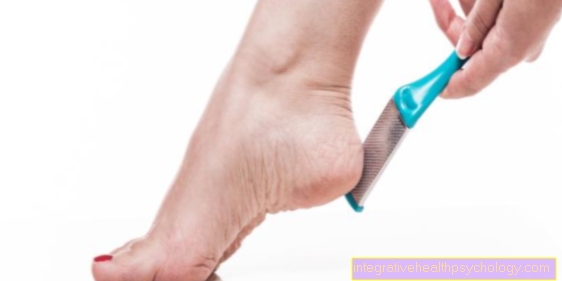Walking / Nordic Walking
Synonyms in a broader sense
Walking, Nordic walking, power walking, walking, sports
introduction

Walking and especially Nordic walking are among the most successful trend sports in recent years. Both sports belong to the field of endurance sports and are suitable for almost all people who want to train their cardiovascular system.
General
Walking and Nordic walking are ideally suited for people who have either never played any sport or who may not have been active for years.
These two sports are also of great importance in medical rehabilitation, not only after interventions in the field of orthopedics, but also to successfully increase stress after interventions in the field of internal medicine.
These types of sport are particularly suitable for patients with heart diseases, such as coronary artery disease (CHD), or after bypass surgery.
Here, however, the exercise of the sporting activity must be dosed and, if possible, under expert guidance. Both disciplines are equally suitable for long-term weight reduction in the case of pathological overweight (obesity) and are practiced by many people for this reason. The training science and physiological basics are almost identical for both sports and are therefore explained in the first part of this topic.
The third sport in this category is jogging.
Differences between the disciplines are then specifically explained, especially in terms of technology and equipment for the respective sport.
Training science basics
Regardless of the reason you decide to go walking or Nordic walking, knowledge of some of the basics of training science is essential.
In order to have a positive effect on the cardiovascular system or to lose weight through exercise, regular training is first of all necessary.
Training in the sports medicine sense aims to increase or maintain performance.
The most important prerequisite for an increase in performance / weight reduction here is that the type of sport practiced is performed regularly and several times a week. The intensity and duration of the respective training session are initially of secondary importance.
In order to achieve a continuous improvement in physical fitness in the beginners' area, targeted training at least twice, better three times per week, is necessary.
At the beginning of physical activity, training three times for 20-30 minutes is much more effective than training for 60-90 minutes once a week.
Training effects are based on adaptation processes of the body. The human organism reacts to regular, adapted training stimuli with an increase in performance.
In order to achieve lasting success, it is just as important to allow the body sufficient recovery phases. In the beginners' area, there should be a break of at least 24 hours between two units of endurance training.
Ambitious recreational athletes can shorten this break, or set other priorities in the respective training units, e.g. complete strength training the next day after a long endurance training session.
Exercise intensity
The notes on the intensity of the training load are suggestions for beginners and those returning to the sport. Advanced athletes already have more experience with training control and can usually classify it better than beginners. A lot has already been explained above about the weekly training frequency and duration of the individual units. Here are some notes on the intensity of a single training session.
In endurance sports there are a lot of rules for controlling the training load.
The “trimming 130” principle is often still recommended. With this method, the Heart rate, measurable by the determined training pulse, lie at a frequency of 130 beats per minute.
Another training suggestion indicates that the optimal training range is determined according to the calculation “220 minus age”.
However, both methods are rather imprecise due to the fact that the heart rate is different for each person. Even the physiological (“normal”) resting heart rate varies between 60-80 heartbeats per minute.
As a more reliable method to determine the optimal exercise intensity, the athlete's subjective assessment can be used.
In the beginners' area, you should only train so intensely in the endurance area that entertainment is just possible. This method usually ensures good control of exercise intensity.
ideal structure of a training session
A sensible structure of a training session should consist of three components.
- Warm-up part
This section serves to prepare the organism for the following physical stress. Both gymnastic exercises and easy walking serve as a warm-up program.
For the sports of walking and Nordic walking, there are some simple coordination exercises, such as walking on the spot with a conscious rolling process and targeted movement of the arms.
- Bulk
The longest and most intensive part of the training session should consist of classic “walking” or “Nordic walking”.
- End of training / "cool down"
This part of the training session, also known as "warming up", serves to prepare the body for the end of the load and ideally to initiate the regeneration processes in the body.
For example, stretching exercises or relaxed “going out” are suitable for this.
Walking technique
The basic walking technique is quite easy to learn, after all, when translated, walking means nothing more than "walking", but of course there are some differences to the "normal" gait.
The biggest difference lies in the conscious use of the arms, which set the pace and thus also the speed when walking. The arm movement is opposite to the leg rhythm, which means that when the right foot is moved forward, the left arm swings with it.
This sequence of movements is usually automatic. So you shouldn't think too much about it, especially at the beginning, but just “walk away”. The correct sequence then comes naturally.
However, one should be careful to emphasize the arm swing backwards rather than forwards. The hands are loosely open when walking. Please do not make a fist, this often leads to cramping of the shoulder and neck muscles.
When doing footwork, you should consciously sit down on the heel and then roll over the entire foot.
Nordic walking technique
The main difference between this technique and walking is of course the shared use of Nordic walking sticks.
The sticks themselves are described in more detail in the following chapter on equipment. The rhythm of the steps is also decisive when it comes to Nordic walking. If the left foot touches the ground, there is ground contact with the right stick and vice versa.
The handles of the sticks are not gripped tightly all the time, but rather the hands are opened during the impression phase and the swinging backwards. A loop system specially developed for Nordic Walking poles ensures that they do not “slide away”, but can be safely gripped forwards again in the next swing phase.
Correct technology prevents overload
Tip: If you have decided on Nordic walking as an endurance sport, you should attend a course if possible so that you can learn the right technique right from the start.
Again and again you come across Nordic walkers who, above all, do not really master the use of poles. Under certain circumstances, this can lead to considerable problems in the shoulder and neck area, from tense muscles to the development of a Cervical spine syndrome, up to a bursitis (Subacromial bursitis) in the shoulder joint (see also Impingement syndrome).
equipment
Shoes
As with jogging, the right shoe is probably the most important piece of equipment for both walking and Nordic walking. There are now special walking shoes that are of course also suitable for Nordic walking.
Running shoes are also suitable as walking / Nordic walking shoes, and especially for athletes who want to jog occasionally.
Since walking shoes are less cushioned than running shoes, running training with them is not recommended.
If possible, you should buy the right shoes in a sports or running sports shop, which, in addition to competent advice, often also offers a gait analysis on the treadmill. This allows a trained salesperson to draw conclusions about a suitable running shoe.
dress
Since endurance sports can be practiced in any weather, clothing should of course be adapted to the respective weather conditions.
In the meantime there is also quite good training clothing in the lower and middle price segment that protects against wind and weather influences, but is still breathable.
The Nordic walking stick
When choosing a stick, you should definitely pay attention to good quality. If possible, you should also buy sticks from a specialist dealer. The manufacturers of inexpensive sticks often save on the quality of the material on the one hand and on the loop systems on the other.
To calculate the correct stick length, there is a rule of thumb, "body length times 0.7".
However, the individual leg length plays an important role here, and for this reason, too, competent purchase advice is strongly recommended.





























